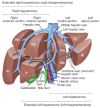Major liver resections, perioperative issues and posthepatectomy liver failure: A comprehensive update for the anesthesiologist
- PMID: 38855273
- PMCID: PMC11155507
- DOI: 10.5492/wjccm.v13.i2.92751
Major liver resections, perioperative issues and posthepatectomy liver failure: A comprehensive update for the anesthesiologist
Abstract
Significant advances in surgical techniques and relevant medium- and long-term outcomes over the past two decades have led to a substantial expansion in the indications for major liver resections. To support these outstanding results and to reduce perioperative complications, anesthesiologists must address and master key perioperative issues (preoperative assessment, proactive intraoperative anesthesia strategies, and implementation of the Enhanced Recovery After Surgery approach). Intensive care unit monitoring immediately following liver surgery remains a subject of active and often unresolved debate. Among postoperative complications, posthepatectomy liver failure (PHLF) occurs in different grades of severity (A-C) and frequency (9%-30%), and it is the main cause of 90-d postoperative mortality. PHLF, recently redefined with pragmatic clinical criteria and perioperative scores, can be predicted, prevented, or anticipated. This review highlights: (1) The systemic consequences of surgical manipulations anesthesiologists must respond to or prevent, to positively impact PHLF (a proactive approach); and (2) the maximal intensive treatment of PHLF, including artificial options, mainly based, so far, on Acute Liver Failure treatment(s), to buy time waiting for the recovery of the native liver or, when appropriate and in very selected cases, toward liver transplant. Such a clinical context requires a strong commitment to surgeons, anesthesiologists, and intensivists to work together, for a fruitful collaboration in a mandatory clinical continuum.
Keywords: Artificial liver support; Chronic liver disease; Intraoperative hemodynamic monitoring; Liver resection; Posthepatectomy liver failure; Postoperative intensive care unit; Preoperative assessment; Vascular clamping.
©The Author(s) 2024. Published by Baishideng Publishing Group Inc. All rights reserved.
Conflict of interest statement
Conflict-of-interest statement: All the authors declare that they have no conflict of interest.
Figures


References
-
- Krige A, Kelliher LJS. Anaesthesia for Hepatic Resection Surgery. Anesthesiol Clin. 2022;40:91–105. - PubMed
-
- Koh YX, Zhao Y, Tan IE, Tan HL, Chua DW, Loh WL, Tan EK, Teo JY, Au MKH, Goh BKP. The impact of hospital volume on liver resection: A systematic review and Bayesian network meta-analysis. Surgery. 2024;175:393–403. - PubMed
-
- Siriwardena AK, Mason JM, Mullamitha S, Hancock HC, Jegatheeswaran S. Management of colorectal cancer presenting with synchronous liver metastases. Nat Rev Clin Oncol. 2014;11:446–459. - PubMed
Publication types
LinkOut - more resources
Full Text Sources
Miscellaneous

